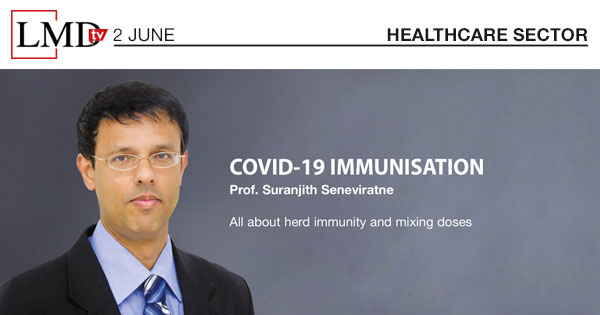LMD TV
“Following the first dose of the AstraZeneca vaccine, the antibody immune system and the cellular lymphocyte immune system get activated after seven to 40 days, and the level increases,” said Prof. Suranjith Seneviratne – Consultant of Clinical Immunology and Allergy at Royal Free Hospital and University College London.
 He explained: “After about 10-12 weeks of the suggested time, you’re expected to get a booster dose to increase the [efficacy] level further.” This will increase both antibodies and white blood cells to a higher level.
He explained: “After about 10-12 weeks of the suggested time, you’re expected to get a booster dose to increase the [efficacy] level further.” This will increase both antibodies and white blood cells to a higher level.
“Immunologically speaking, you can wait a bit longer – say 14 weeks,” he continued. But any further delay will result in diminishing returns. He added that “if you boost it after five months, it can be suboptimal.” Hence the recommended 10-12 week gap with the maximum being 14 weeks.
He addressed the confusion pertaining to mixing vaccines for the second dose: “Countries such as Germany, France, Denmark and Norway changed regulations due to the small risk of clots.” Having administered AstraZeneca for the first dose, these nations turned to Pfizer or Moderna for the second round.
Millions of people have faced this situation and the choice of vaccine was determined by which of them were registered in the country in question.
Considering the situation in Sri Lanka, he commented: “If you can get the AstraZeneca vaccine, go for it – but you can’t wait until October or November for the second dose as that won’t make you immunologically safe,” If not, Pfizer or Moderna are worthwhile options to consider for the second dose.
Seneviratne pointed out that “Sputnik is similar to AstraZeneca. It’s a viral vector vaccine and a chimpanzee adenovirus.” Meanwhile, Sinopharm is a killed vaccine. Such vaccines have been used for many years for immunisation.
Therefore, both these vaccines are possible options although millions in the West have been vaccinated with Pfizer or Moderna.
Seneviratne illustrated the impact of a delayed second dose: “After vaccination, the antibody and cellular immune systems – and the cell-based lymphocytes – increase to a peak, which then diminishes gradually.” Consequently, a timely second dose is crucial.
Moreover, countries like the UK are considering a third dose to improve immunity.
“Countries have to decide the best ways to use the different vaccines based on demand and supply,” Seneviratne asserted. For example, the UK looked at its healthcare facilities and decided that those over 60 would be vaccinated first.
He also added that “Canada and the UK allow vaccination for ages 12 and above but even in the UK, 18-25-year-olds are still waiting for their vaccination.” In Sri Lanka meanwhile, only the 30-plus age group has been vaccinated at this time.
The WHO approved Sinopharm for people above 18 but the government has allocated stocks based on its availability, he pointed out, adding that “the WHO regularly addresses vaccine equity.”
Seneviratne said: “If you vaccinate the entire population of one country, you reach herd immunity; but when a viral variant occurs in another country, you will be back to square one.” Herd immunity attained by vaccinating a certain percentage of the population will ensure that the rest of the citizenry is protected.
Speaking about variants, he asserted that the South African variant is the one to be mindful of.
Similarly, the black fungus Mucormycosis may come to the fore if there is damage to the vascular vessel wall. This has been the case in India, according to Seneviratne who also remarked that this being an environmental fungus, countries such as Sri Lanka and India are more vulnerable to it.
He ended with the view that people must be educated on vaccination because it is only natural to be overwhelmed by the sheer volume of scientific jargon that’s being discussed. Having said that, the anti-vaxxers may not change their perspective until more information surfaces, he added.



